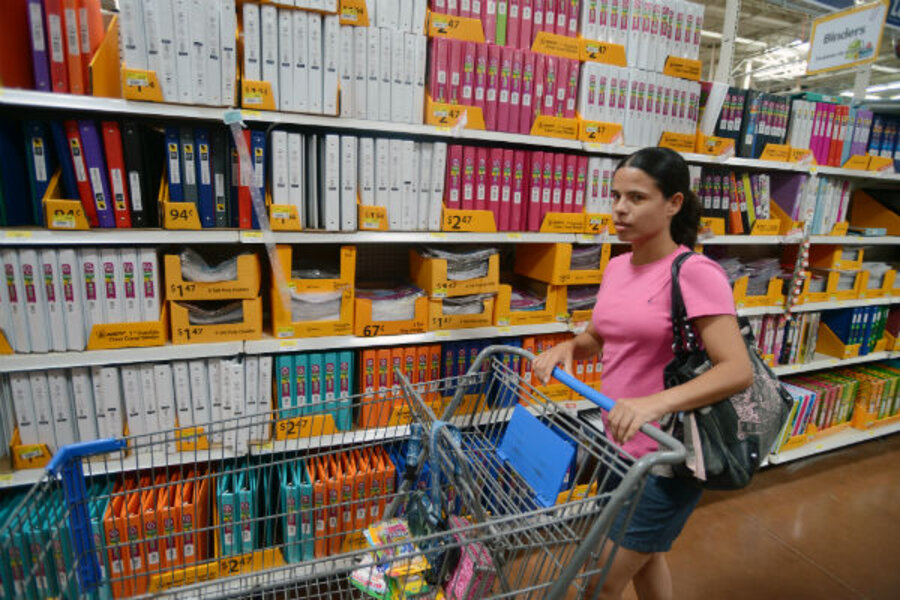School supplies: How to give, and receive, supplies in time for the first bell
Loading...
The National Retail Federation estimates that this year, an average family will spend $669.28 on back-to-school items, up from $634.78 from 2013. For many families, the cost of back-to-school clothes, shoes, and supplies is one that they cannot afford.
As a teacher, I have learned firsthand the costs for school supplies, and have learned a few tips to help families cut back on costs.
First, there are many national programs that distribute and help with supplies such as Kids in Need Foundation and United Way. Moreover, many chapters of The Salvation Army partner with local organizations to provide free school supplies to children in need. Also, Back-To-School Brigade works with Dollar Tree stores to supply millions of dollars of free school supplies across the nation.
Many of the above organizations provide multiple drop off locations throughout local communities to collect school supplies to distribute. Make sure to check their Facebook pages, as well as your local newspaper and television news to find information to see who is distributing supplies this year. Often, schools will also have information about local programs.
Col. Ron Busroe, community relations and development secretary for The Salvation Army says that parents who need help with school supplies should contact their local Salvation Army. "Many Salvation Army locations provide back to school assistance, and for those looking to receive support as the school year begins, it is best to contact your local Salvation Army by visiting SalvationArmyUSA.org and typing in your zip code," he wrote via e-mail. "In addition, those looking to help are encouraged to drop off commonly needed items at their local Salvation Army."Often, the local branches of national organizations have different ways to distribute school supplies. For example, the Massachusetts Salvation Army hands out backpacks and supplies at a Back to School Celebration, which includes activities and educational booths. Families must pre-register for the Back to School Celebration, which is taking place on Aug. 26.
My good friend, Reshma Khan, who founded a free women’s clinic in Charleston, S.C., organizes a Back-2-School Giveaway, under ICNA Relief USA, and through her local program, passes out hundreds of dollars of school supplies and book bags every year. Cities in 12 states across the US participate in the program.
I encourage parents to have their children to volunteer at such events. Khan always takes her three young children to help where they directly pass out the book bags with school supplies to other children. As a result, her kids are more socially-conscious of the world around them and are more appreciative of their own blessings.
As for those who want to save money on the back-to-school list that many schools produce, stick to the must-have basics. Always make sure to check if there is any leftover supplies from last year’s supplies. Think about buying certain items in bulk, including items from Costco or Sam’s Club, for the whole family to use. Also, don’t throw out the list once school begins – keep it for the end of the school year when school supplies are on clearance.
Plus, do-it-yourself items, like book covers, totes, and pencil cases. are always a good project to make with kids to help personalize their school supplies, and will save families extra cash.
As for clothes, shoes, and uniforms, having that First Day of School outfit is important to many children, especially if they are starting middle school or high school. Have them choose a decently-priced outfit, but if your budget is tight, explore local thrift shops and local Facebook shop-and-swap groups. My favorite coupon and cash back apps and websites are GeoQpons, RetailMeNot, Snip Snap,Ebates and Shopkick.
Most importantly, remember that in many parts of the world, teaching and learning are done with very little supplies. If you cannot afford some of the extra items on your child’s supply list, talk directly to your child’s teacher about what items could be missed, and then check with local organizations for the must-haves.
Before submitting to sticker shock from a cartload of items at the checkout, think first about what can be re-used, refreshed, and refurbished from your current supplies. And if you are in a position to fill your cart, be sure to grab extra to donate to others and have your children directly participate in giving school supplies to community members in need.








